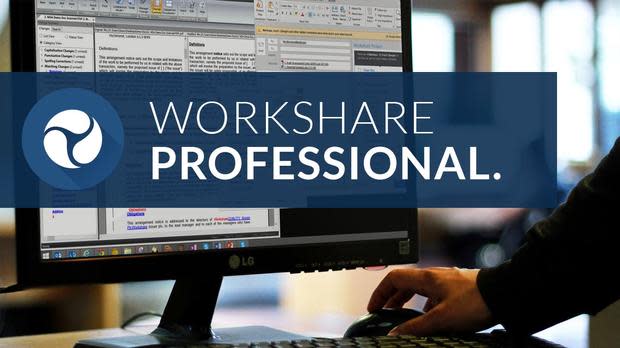Email isn't going away anytime soon, asserts Workshare's CTO

Workshare Professional 9
Image: Workshare
There's a debate in the business community about the utility of email and its future. Workshare's CTO Barrie Hadfield thinks it has a future and says that, despite its shortcomings (which I am quick to point out), "email will continue to be a very popular method of communication for a long time."
In a Q&A with TechRepublic, he shared that email has achieved "mass adoption," with roughly 183 billion messages sent/received per day, and won't be replaced soon. "Instead," he argues, "more applications will emerge that compensate for email's weaknesses, driving more effective collaboration among groups." He points out, in addition, that email is a major source of big data information.
London-based Workshare provides secure enterprise file sharing and collaboration applications. The firm announced the ninth version of its collaboration solution, Workshare Professional, in August 2014. Its file-sharing solution is Workshare Connect.
Also in our Q&A discussion, Hadfield talked about contextual (or document-centric) collaboration, the influence of consumerization on the tech industry, and the importance of focusing on people, internally and externally, in the software industry.
TechRepublic: How would you respond to this question? I believe (blank) will replace email as an enterprise collaboration tool, and here are the reasons why.
Barrie Hadfield: There are animated discussions, particularly within startup communities, about email's future. A predominant argument is that, while it's an effective tool for communicating one-to-one or in small groups, email's limitations make collaborating with multiple people a serious challenge. For instance, how many times have you searched through several email threads to find an attachment, only to find out later that you're two, maybe even three, versions behind?

Barrie Hadfield
Image courtesy of Workshare
Despite certain drawbacks, email will continue to be a very popular method of communication for a long time. Email is the largest collaboration tool in the world, with 182.9 billion emails sent/received per day worldwide -- a number that will only continue to grow. It is ingrained in everyone's workflow, and given this mass adoption, it will be difficult to propose a suitable alternative for linear communication on such a large scale. Instead, more applications will emerge that compensate for email's weaknesses, driving more effective collaboration among groups.
In the emerging world of big data, email is such a rich mine of information. It "knows" so much about its user that it can deliver real insight and value to a business when used in conjunction with other applications, such as collaboration applications and calendars. It will be through this convergence with other forms of digital communication that it will continue to deliver real business value as a collaboration tool.
TechRepublic: How would you define "contextual collaboration," and how does Workshare enable it?
Barrie Hadfield: Contextual collaboration is all about having everything you need to evolve a business document in one place. We also call this document-centric collaboration, and it is achieved through the integration of all the tools a document owner needs, accessible from anywhere. Workshare enables this by providing secure workspaces that center around a document as the starting point for collaboration.
Another aspect of contextual collaboration is to ensure that it is always relevant. From providing a structure where only the most significant information is surfaced to the user, to having the ability to comment directly on a document so that all conversations take place in context.
To help further support this, Workshare has a number of integrations. The most important are those with existing Enterprise Content Management (ECM) and Document Management Systems (DMS) like Microsoft SharePoint. We also have deep integrations with Microsoft Office, which for example, allows users to save or share files directly to Workshare from within Word. This means that users can continue using the legacy systems they're accustomed to, but with added flexibility and enhancements via Workshare.
TechRepublic: Let's say I am an IT decision maker at a medium to large enterprise. What are the benefits of adopting Workshare Professional 9 for my organization?
Barrie Hadfield: Professional 9 helps drive efficiency and productivity. A lot of organizations are facing issues around effective document-centric collaboration, and do not have tools or applications in place that enable users to stay as productive as possible, no matter where they are. Applications such as these target resourcing issues head on, allowing users to spend less time on admin, and more time on getting the job done.
It caters to mobile knowledge workers by allowing them to access, compare, and collaborate on documents from anywhere. Unlike most legacy systems which lack flexibility for working on-the-go, Workshare provides cloud and mobile support to enable them to stay productive on the move. The added data security that comes with Professional 9 is paramount from an IT perspective, as it ensures data is secure at all times.
TechRepublic: Security is no doubt on many people's minds these days, because of the news about big corporate breaches. What security features are built into Professional 9, as well as your other offerings?
Barrie Hadfield: Workshare was built from day one as an enterprise-grade solution, blending the usability of consumer cloud file sharing and collaboration applications that users want, with the security that the enterprise needs.
When we designed our cloud proposition, we incorporated metadata cleaning and policy enforcement features into the application. This means content is secure no matter where it is accessed or sent from. Content that is sensitive and confidential is not always immediately visible. Most documents contain hidden data (metadata), such as file size, author or date modified, which can be damaging if exposed. With Professional 9, metadata is automatically identified and removed from files and attachments before they are sent, so users don't have to think twice about sensitive data they might be inadvertently sharing.
Workshare also provides data storage location options for our products. This means that our customers can choose between a secure public cloud, with specific locations for data storage, or a hybrid cloud (on-premise) deployment that keeps data behind a private firewall. Customers have the ability to hold data and documents within a data center in the UK, Europe, APAC, and the US. This unique set of data location options give organizations the control they need to ensure data is held in a specific jurisdiction or data location 100% owned, managed, controlled, and protected by them. For enterprises in highly-regulated industries this level of protection and control is crucial.
TechRepublic: What kind of market traction and feedback are you seeing since the release of Workshare Professional 9 last year?
Barrie Hadfield: Since revealing Professional 9 last summer, we've seen excellent momentum, particularly in the legal sector. According to ILTA's Technology Survey (PDF), Workshare is the most widely used product in the legal sector. As many as 2,000 firms have adopted Professional 9 since it became available in December, making up a user base of 2 million.
The rapid adoption of Professional 9 has been the fastest growth we have seen and is a significant milestone, which highlights the market's need for products that drive efficiencies across the entire document review cycle. We think this attests to enterprises' needs for a product that can cut down on admin and document review cycle times and boost overall productivity.
TechRepublic: What trends in workforce mobility do you see for 2015-2016?
Barrie Hadfield: In the last few years there has been a significant rise in the number of consumer-grade file sharing and collaboration applications being used for work, with a shift in power from IT to the user. This trend will continue through 2016, as knowledge workers increasingly turn to intuitive and easy-to-use applications for collaboration, that allow them to continue working from anywhere. As a result, we expect to see consumers increasingly driving the mobility agenda at work.
As such, more and more IT groups will deploy secure applications that accommodate users' needs, rather than dictate what solutions should be used in the workplace. To do this, organizations must look beyond the hype, adopting useful software that empowers employees, but also minimizes risk by ensuring sensitive content and intellectual property stays secure at all times.
TechRepublic: You have a career in technology that is now in its third decade. What is the most significant change in technology -- whether consumer or enterprise or both -- that you've seen during that time?
Barrie Hadfield: In the past, a software company had relationships with the buyers. The word "customer" in those days meant the buyer, or the people whose job it was to implement the software. Today the word "customer" means something different. It refers to the actual person, the user of the software. This is a profound change and many companies are still getting to grips with it. Everything in this world is different, you have to think about every single person using your software and find a way to help them when they need you and stay out of their way when they don't. This shift has been the biggest change.
TechRepublic: Congratulations on being a nominee in the "Technology Hero of the Year" category at the V3 awards held in London last November. What experiences have helped you reach this stage in your career?
Barrie Hadfield: I think the biggest and most important learning experience for me has been that software is all about people, and not about technology. I mean this in two ways. Firstly, from a customer perspective, it is absolutely important that a software company realizes that its job is to solve customers' problems, and it just so happens that software is the way in which customers can solve them. Many software companies believe their job is just to create software, and these are the ones who generally don't have customers.
Secondly, from an internal perspective it's all about people. You need to work hard to make sure you have the right culture and values, and that you have a company made up of people who you enjoy, respect, and love working with. Without this, a company loses its heart, and companies without heart are never successful -- from both a commercial and personal point of view.


